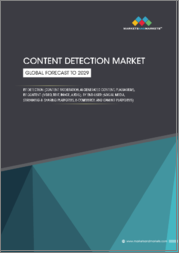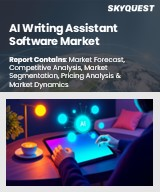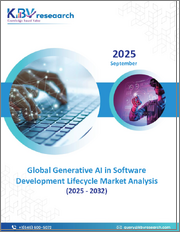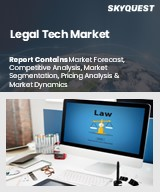
|
시장보고서
상품코드
1618942
세계의 컨텐츠 검출 시장 : 검출 유형별, 컨텐츠 유형별, 제공 제품별, 최종 사용자별, 지역별 - 예측(-2029년)Content Detection Market by Detection Type (Content Moderation, AI-generated Content Detection, Plagiarism Detection), Content Type (Video, Text, Image, Audio), Offering (Solutions, Services), End- User, and Region - Global Forecast to 2029 |
||||||
컨텐츠 검출 시장 규모는 2024년 164억 8,000만 달러로 평가되었고, 2029년 314억 2,000만 달러에 이를 것으로 예측되며, 예측 기간 중 연간 평균 성장률(CAGR)은 16.9%가 될 것으로 전망됩니다.
컨텐츠 검출 시장은 디지털 컨텐츠의 급증으로 인한 저작권에 대한 관심과 컨텐츠 보호의 필요성으로 인한 견인력을 늘리고 있습니다. 코스모폴리타니즘은 소셜 네트워크의 확대를 가져오고, 비전문적인 컨텐츠가 증가함에 따라 고급 중재 및 검출 도구가 필요합니다.
| 조사 범위 | |
|---|---|
| 조사 대상년도 | 2019-2029년 |
| 기준년 | 2023년 |
| 예측 기간 | 2024-2029 |
| 검토 단위 | 달러(10억 달러) |
| 부문별 | 검색 유형별, 컨텐츠 유형별, 제공 제품별, 최종 사용자별, 지역별 |
| 대상 지역 | 북미, 유럽, 아시아태평양, 중동, 아프리카, 라틴아메리카 |
컨텐츠 모더레이션은 혐오 발언, 허위 정보, 음란물, 분란을 제거하는 데 도움이 되며, 많은 디지털 플랫폼에 걸쳐 있습니다. 예를 들어, 소셜 미디어 플랫폼은 괴롭힘이나 루머의 확산으로부터 사용자를 보호하기 위해 콘텐츠 모델링 기술에 의존하고 있습니다. 동시에 e커머스 사이트에서는 규칙 위반이나 사기 가능성을 억제하기 위해 내부 구조로 모든 게시물과 리뷰를 체크하고 있습니다. 콘텐츠 모델링 솔루션에는 AI, 기계학습, 자연어처리(NLP), 컴퓨터 비전 등의 요소가 포함돼 텍스트, 이미지, 음성, 동영상의 자동 스캔과 필터링을 용이하게 합니다. 실시간 모더레이션, 온라인 플랫폼에서 필요로 하는 다국어 능력의 대두, 온라인 플랫폼 내에 잘 통합된 문화에 민감한 시스템의 필요성으로 인해 온라인 콘텐츠 모더레이션은 온라인에서 질 높은 경험을 달성하는 데 점점 더 중요해지고 있습니다.
AI 생성 컨텐츠 검출 도구의 중요성은 다양한 분야에서 진정성, 도덕성, 법의 지배 준수를 유지하는데 있어서 두드러집니다. 교육 분야에서는 AI의 도움을 받아 표절된 자료의 제출을 검출함으로써 학문적 부정행위 유지에 도움이 됩니다. 소셜 미디어 네트워크는 허위 정보의 확산이나 조작된 이미지, 스팸 또는 AI에 의해 만들어진 딥페이크와 같은 파괴적인 콘텐츠의 유통을 막는 데 도움이 됩니다. 뉴스 및 미디어에서는 공개된 뉴스를 감시하고, 특히 인공적으로 작성되었다고 생각되는 사진, 비디오, 기사에는 태그를 붙입니다. 게다가 이 기술은 가짜 리뷰, 가짜 상품 사진, 오해를 불러일으키는 광고를 제거함으로써 소매 및 e커머스 등의 분야에서 추가적인 역할을 하고 있습니다.
본 보고서에서는 세계의 컨텐츠 검출 시장에 대해 조사했으며, 검출 유형별, 컨텐츠 유형별, 제공 제품별, 최종 사용자별, 지역별 동향 및 시장 진출기업 프로파일 등을 정리했습니다.
목차
제1장 서론
제2장 조사 방법
제3장 주요 요약
제4장 중요 인사이트
제5장 시장 개요 및 업계 동향
- 서문
- 시장 역학
- 업계 동향
제6장 컨텐츠 검출 시장 : 제공 제품별
- 서문
- 솔루션
- 서비스
제7장 컨텐츠 검출 시장 : 검출 유형별
- 서문
- 컨텐츠 모더레이션
- AI 생성 컨텐츠 검출
- 표절 검출
- 기타
제8장 컨텐츠 검출 시장 : 컨텐츠 유형별
- 서문
- 동영상
- 텍스트
- 이미지
- 음성
제9장 컨텐츠 검출 시장 : 최종 사용자별
- 서문
- 소셜 미디어 플랫폼
- 스트리밍 및 컨텐츠 공유 플랫폼
- 소매 및 전자상거래
- 게임 플랫폼
- 기타
제10장 컨텐츠 검출 시장 : 지역별
- 서문
- 북미
- 북미의 거시경제 전망
- 미국
- 캐나다
- 유럽
- 유럽의 거시 경제 전망
- 영국
- 독일
- 프랑스
- 기타
- 아시아태평양
- 아시아태평양의 거시 경제 전망
- 중국
- 일본
- 인도
- 기타
- 중동 및 아프리카
- 중동 및 아프리카의 거시경제 전망
- GCC 국가
- 남아프리카
- 기타
- 남미
- 남미의 거시경제 전망
- 브라질
- 멕시코
- 기타
제11장 경쟁 구도
- 서문
- 주요 진입기업의 전략 및 강점
- 수익 분석(2019-2023년)
- 시장 점유율 분석(2023년)
- 기업평가 매트릭스 : 주요 진입기업(2023년)
- 기업평가 매트릭스 : 스타트업 및 중소기업(2023년)
- 경쟁 시나리오 및 동향
- 브랜드 및 제품 비교
- 기업 가치 평가 및 재무지표
제12장 기업 프로파일
- 주요 진출기업
- MICROSOFT
- AMAZON
- IBM
- ALIBABA CLOUD
- HCL TECHNOLOGIES
- WIPRO
- HUAWEI CLOUD
- ACCENTURE
- CLARIFAI
- 기타 기업
- COGITO TECH
- TASKUS
- COGNIZANT
- PROOFPOINT
- CONCENTRIX
- 스타트업 및 중소기업
- SUNTEC.AI
- BESEDO
- ACTIVEFENCE
- SENSITY
- HIVE
- QUILLBOT
- ORIGINALITY AI
- IMERIT TECHNOLOGY
- DATALOOP
- WEBPURIFY
제13장 인접 시장 및 관련 시장
제14장 부록
AJY 25.01.06The content detection market is estimated at USD 16.48 billion in 2024 to USD 31.42 billion by 2029 at a Compound Annual Growth Rate (CAGR) of 16.9% during the forecast period. The content detection market is gaining traction due to increased copyright concerns and the need for content protection resulting from the upsurge of digital content. Cosmopolitanism brought about this expansion of social networks and came along with the increase in nonprofessional content, calling for advanced moderation and detection tools.
| Scope of the Report | |
|---|---|
| Years Considered for the Study | 2019-2029 |
| Base Year | 2023 |
| Forecast Period | 2024-2029 |
| Units Considered | USD (Billion) |
| Segments | By Offering (Solutions, Services ), By Detection Type, By Content Type, By End User |
| Regions covered | North America, Europe, Asia Pacific, Middle East & Africa, and Latin America. |
"By detection type, the content moderation segment to hold the largest market size during the forecast period."
Content moderation helps to eliminate hate speech, false information, obscene material, or trolling but extends to many digital platforms. Social media platforms, for instance, rely on content moderation techniques to protect users against bullying and also the spreading of falsehoods. At the same time, in e-commerce sites, internal structures check all postings and reviews to deter any possible rule infringements and scamming. Content moderation solutions include elements like AI, machine learning, natural language processing (NLP), and computer vision to facilitate the automated scanning and filtering of text, images, audio and videos, usually complemented by human control for more subjective cases. With real-time moderation, the rise of needed multilingual abilities for online platforms, and the need for culture-sensitive systems that are well integrated within online platforms, online content moderation is increasingly critical in achieving a quality experience online.
"By detection type, the AI-generated content detection segment to register the fastest growth rate during the forecast period."
The importance of AI-generated content detection tools is eminent in preserving authenticity, morality and adherence to rule of law in various fields. In education, it helps in maintaining academic misconduct by detecting the submission of plagiarized materials with the help of AI. Social media networks help prevent the spread of false information and the distribution of disruptive content like fabricated images, spam, or even deepfakes created by AI. In news & media, it monitors published news, especially tagging any photo, video, or article that appears artificially generated. Furthermore, this technology serves additional purposes in areas such as retail & e-commerce by eradicating fake reviews, false product pictures, and misleading advertisements.
"By region, Asia Pacific is expected to have the highest growth rate during the forecast period."
The content detection market is growing fastest in the Asia Pacific region. The increasing consumption of user-generated content, the need for plagiarism detection services, and the development of tools employing advanced AI capabilities, such as ML and NLP are responsible for the thriving content detection industry in the region. The increase in the number of business transactions taking place online and the sheer amount of content generated daily also necessitates the need to promote safer interaction among business partners and adhere to industry standards. Content moderation is in high demand in India and China, which have vast user interactions. Given the regional linguistic and cultural diversity, content detection tools that incorporate machine learning, natural language processing, and computer vision techniques are used to minimize the manual processes of detecting undesirable text, pictures, audio, and videos.
In-depth interviews have been conducted with chief executive officers (CEOs), Directors, and other executives from various key organizations operating in the Content detection market.
- By Company Type: Tier 1 - 35%, Tier 2 - 40%, and Tier 3 - 25%
- By Designation: C Level Executives - 35%, Managers - 25%, and Others - 40%
- By Region: North America - 30%, Europe - 25%, Asia Pacific - 35%, RoW - 10%
The major players in the Content detection market include Microsoft (US), Google (US), Amazon (US), Alibaba Cloud (China), IBM (US), HCL Technologies (India), Huawei Cloud (China), Wipro (India), Accenture (Ireland), Clarifai (US). These players have adopted various growth strategies, such as partnerships, agreements and collaborations, new product launches, enhancements, and acquisitions to expand their Content detection market footprint.
Research Coverage
The market study covers the content detection market size across different segments. It aims to estimate the market size and the growth potential across various segments, including By Offering (Solutions, and Services (Professional Services (Consulting & Advisory, Implementation & Integration, Support & Maintenance), Managed Services)), By Detection Type (Content Moderation, AI-Generated Content Detection, Plagiarism Detection, and Other Detection Types), By Content Type (Video, Text, Image, and Audio), By End User (Social Media Platforms, Streaming & Content Sharing Platforms, Retail & eCommerce, Gaming Platforms, and Other End Users) and Region (North America, Europe, Asia Pacific, Middle East & Africa, and Latin America). The study includes an in-depth competitive analysis of the leading market players, their company profiles, key observations related to product and business offerings, recent developments, and market strategies.
Key Benefits of Buying the Report
The report will help market leaders and new entrants with information on the closest approximations of the global content detection market's revenue numbers and subsegments. It will also help stakeholders understand the competitive landscape and gain more insights to better position their businesses and plan suitable go-to-market strategies. Moreover, the report will provide insights for stakeholders to understand the market's pulse and provide them with information on key market drivers, restraints, challenges, and opportunities.
The report provides insights on the following pointers:
Analysis of key drivers (Increasing online content volume, rising advancements in AI and ML, rising concerns over content authenticity), restraints (Adapting to legal and regulatory requirements, complexity in language and cultural nuances), opportunities (Increasing demand for real-time moderation solutions, integration with social media and live streaming), and challenges (Managing large volumes of content, data security and privacy concerns).
1. Product Development/Innovation: Detailed insights on upcoming technologies, research & development activities, and new product & service launches in the content detection market.
2. Market Development: The report provides comprehensive information about lucrative markets and analyses the content detection market across various regions.
3. Market Diversification: Exhaustive information about new products & services, untapped geographies, recent developments, and investments in the content detection market.
4. Competitive Assessment: In-depth assessment of market shares, growth strategies and service offerings of leading include Microsoft (US), Google (US), Amazon (US), Alibaba Cloud (China), IBM (US), HCL Technologies (India), Huawei Cloud (China), Wipro (India), Accenture (Ireland), Clarifai (US), Cogito Tech (US), TaskUS (US), Cognizant (US), Proofpoint (US), Concentrix (US), SunTec.ai (US), Besedo (Sweden), ActiveFence (US), Sensity (Netherlands), Hive (US), QuillBot (US), Originality AI (Canada), Imerit Technology (US), Dataloop (Israel), WebPurify (US).
TABLE OF CONTENTS
1 INTRODUCTION
- 1.1 STUDY OBJECTIVES
- 1.2 MARKET DEFINITION
- 1.2.1 INCLUSIONS AND EXCLUSIONS
- 1.3 MARKET SCOPE
- 1.3.1 MARKET SEGMENTATION
- 1.3.2 YEARS CONSIDERED
- 1.4 CURRENCY CONSIDERED
- 1.5 STAKEHOLDERS
2 RESEARCH METHODOLOGY
- 2.1 RESEARCH DATA
- 2.1.1 SECONDARY DATA
- 2.1.1.1 Key data from secondary sources
- 2.1.2 PRIMARY DATA
- 2.1.1 SECONDARY DATA
- 2.2 MARKET SIZE ESTIMATION
- 2.2.1 TOP-DOWN APPROACH
- 2.2.2 BOTTOM-UP APPROACH
- 2.3 DATA TRIANGULATION
- 2.4 MARKET FORECAST
- 2.5 RESEARCH ASSUMPTIONS
- 2.6 RESEARCH LIMITATIONS
3 EXECUTIVE SUMMARY
4 PREMIUM INSIGHTS
- 4.1 GROWTH OPPORTUNITIES FOR PLAYERS IN CONTENT DETECTION MARKET
- 4.2 CONTENT DETECTION MARKET, BY OFFERING
- 4.3 CONTENT DETECTION MARKET, BY DETECTION TYPE
- 4.4 CONTENT DETECTION MARKET, BY END USER
- 4.5 NORTH AMERICA: CONTENT DETECTION MARKET, BY OFFERING AND CONTENT TYPE
5 MARKET OVERVIEW AND INDUSTRY TRENDS
- 5.1 INTRODUCTION
- 5.2 MARKET DYNAMICS
- 5.2.1 DRIVERS
- 5.2.1.1 Increasing online content volume
- 5.2.1.2 Rise in advancements in AI and ML
- 5.2.1.3 Rising concerns over content authenticity
- 5.2.2 RESTRAINTS
- 5.2.2.1 Adapting to legal and regulatory requirements
- 5.2.2.2 Complexity in language and cultural nuances
- 5.2.3 OPPORTUNITIES
- 5.2.3.1 Increasing demand for real-time moderation solutions
- 5.2.3.2 Integration with social media and live-streaming
- 5.2.4 CHALLENGES
- 5.2.4.1 Managing large volumes of content
- 5.2.4.2 Data security and privacy concerns
- 5.2.1 DRIVERS
- 5.3 INDUSTRY TRENDS
- 5.3.1 BRIEF HISTORY OF CONTENT DETECTION MARKET
- 5.3.1.1 2000-2010
- 5.3.1.2 2010-2020
- 5.3.1.3 2020-Present
- 5.3.2 DISRUPTIONS IMPACTING BUYERS/CUSTOMERS
- 5.3.3 PRICING ANALYSIS
- 5.3.3.1 Average selling price trend of key players, by detection type
- 5.3.3.2 Indicative pricing analysis of content detection solutions & services
- 5.3.4 SUPPLY CHAIN ANALYSIS
- 5.3.4.1 Technology providers
- 5.3.4.2 Data providers
- 5.3.4.3 Service providers
- 5.3.4.4 End users
- 5.3.5 ECOSYSTEM/MARKET MAP
- 5.3.6 TECHNOLOGY ANALYSIS
- 5.3.6.1 Key technologies
- 5.3.6.1.1 Natural language processing (NLP)
- 5.3.6.1.2 Machine learning (ML)
- 5.3.6.1.3 Deep learning
- 5.3.6.2 Adjacent technologies
- 5.3.6.2.1 Robotic process automation (RPA)
- 5.3.6.2.2 Cloud computing
- 5.3.6.3 Complementary technologies
- 5.3.6.3.1 Data analytics
- 5.3.6.3.2 Computer vision
- 5.3.6.1 Key technologies
- 5.3.7 PATENT ANALYSIS
- 5.3.7.1 Methodology
- 5.3.8 CASE STUDIES
- 5.3.8.1 CoStar Group delivered efficient content moderation and image processing for commercial real-estate using AWS
- 5.3.8.2 AWS powered Dream11's vision to improve future of sports for 220 million fans
- 5.3.8.3 Plato used Hive's moderation models across all content produced by their users
- 5.3.9 KEY CONFERENCES & EVENTS, 2024-2025
- 5.3.10 CURRENT AND EMERGING BUSINESS MODELS
- 5.3.11 BEST PRACTICES
- 5.3.12 TOOLS, FRAMEWORKS, AND TECHNIQUES
- 5.3.13 FUTURE LANDSCAPE OF CONTENT DETECTION MARKET
- 5.3.13.1 Content detection technology roadmap till 2030
- 5.3.13.2 Short-term Roadmap (2024-2025)
- 5.3.13.3 Mid-term Roadmap (2026-2028)
- 5.3.13.4 Long-term Roadmap (2029-2030)
- 5.3.14 REGULATORY LANDSCAPE
- 5.3.14.1 REGULATORY BODIES, GOVERNMENT AGENCIES, AND OTHER ORGANIZATIONS
- 5.3.14.2 Regulations
- 5.3.14.2.1 North America
- 5.3.14.2.1.1 US
- 5.3.14.2.1.2 Canada
- 5.3.14.2.2 Europe
- 5.3.14.2.2.1 UK
- 5.3.14.2.2.2 France
- 5.3.14.2.2.3 Germany
- 5.3.14.2.2.4 Spain
- 5.3.14.2.3 Asia Pacific
- 5.3.14.2.3.1 Australia
- 5.3.14.2.3.2 China
- 5.3.14.2.3.3 India
- 5.3.14.2.3.4 Japan
- 5.3.14.2.3.5 South Korea
- 5.3.14.2.3.6 Singapore
- 5.3.14.2.3.7 Taiwan
- 5.3.14.2.4 Middle East & Africa
- 5.3.14.2.4.1 UAE
- 5.3.14.2.4.2 Saudi Arabia
- 5.3.14.2.4.3 Qatar
- 5.3.14.2.4.4 Egypt
- 5.3.14.2.4.5 South Africa
- 5.3.14.2.4.6 Kenya
- 5.3.14.2.4.7 Nigeria
- 5.3.14.2.5 Latin America
- 5.3.14.2.5.1 Brazil
- 5.3.14.2.5.2 Mexico
- 5.3.14.2.5.3 Argentina
- 5.3.14.2.1 North America
- 5.3.15 PORTER'S FIVE FORCES MODEL
- 5.3.15.1 Threat of new entrants
- 5.3.15.2 Threat of substitutes
- 5.3.15.3 Bargaining power of suppliers
- 5.3.15.4 Bargaining power of buyers
- 5.3.15.5 Intensity of competitive rivalry
- 5.3.16 KEY STAKEHOLDERS AND BUYING CRITERIA
- 5.3.16.1 Key stakeholders in buying process
- 5.3.16.2 Buying criteria
- 5.3.17 INVESTMENT & FUNDING SCENARIO
- 5.3.18 ARTIFICIAL INTELLIGENCE AND GENERATIVE AI
- 5.3.18.1 Impact of generative AI on content detection
- 5.3.18.2 Use cases of generative AI in content detection
- 5.3.18.3 Future of generative AI in content detection
- 5.3.1 BRIEF HISTORY OF CONTENT DETECTION MARKET
6 CONTENT DETECTION MARKET, BY OFFERING
- 6.1 INTRODUCTION
- 6.1.1 OFFERING: CONTENT DETECTION MARKET DRIVERS
- 6.2 SOLUTIONS
- 6.3 SERVICES
- 6.3.1 PROFESSIONAL SERVICES
- 6.3.1.1 Increase in complexity of digital content ecosystems and stringent regulatory requirements
- 6.3.1.2 Consulting & advisory
- 6.3.1.3 Implementation & integration
- 6.3.1.4 Support & maintenance
- 6.3.2 MANAGED SERVICES
- 6.3.2.1 End-to-end outsourcing solutions for organizations that wish to reduce in-house operational burdens
- 6.3.1 PROFESSIONAL SERVICES
7 CONTENT DETECTION MARKET, BY DETECTION TYPE
- 7.1 INTRODUCTION
- 7.1.1 DETECTION TYPE: CONTENT DETECTION MARKET DRIVERS
- 7.2 CONTENT MODERATION
- 7.2.1 NEED TO PROTECT USERS AGAINST BULLYING AND ALSO SPREADING OF FALSEHOODS
- 7.3 AI-GENERATED CONTENT DETECTION
- 7.3.1 PREVENTION OF DATA MISUSE, SUCH AS FAKE NEWS, DEEPFAKES, AND SYNTHETIC MEDIA
- 7.4 PLAGIARISM DETECTION
- 7.4.1 NEED TO ENSURE ORIGINALITY OF TEXT-BASED CONTENT
- 7.5 OTHER DETECTION TYPES
8 CONTENT DETECTION MARKET, BY CONTENT TYPE
- 8.1 INTRODUCTION
- 8.1.1 CONTENT TYPE: CONTENT DETECTION MARKET DRIVERS
- 8.2 VIDEO
- 8.2.1 CRITICAL IN DETECTING VIOLENCE AND HATE SPEECH WITHIN VIDEO STREAMS
- 8.3 TEXT
- 8.3.1 INSTRUMENTAL IN APPLICATIONS FOR ACADEMIC INSTITUTIONS AND MEDIA OUTLETS, WITH RISE OF GEN AI MODELS SUCH AS CHATGPT
- 8.4 IMAGE
- 8.4.1 DEMAND TO PREVENT COUNTERFEIT PRODUCT LISTINGS AND PROTECT BRAND INTEGRITY
- 8.5 AUDIO
- 8.5.1 DETECTING HATE SPEECH OR OFFENSIVE COMMENTS IN REAL-TIME AUDIO
9 CONTENT DETECTION MARKET, BY END USER
- 9.1 INTRODUCTION
- 9.1.1 END USER: CONTENT DETECTION MARKET DRIVERS
- 9.2 SOCIAL MEDIA PLATFORMS
- 9.2.1 LARGE VOLUME OF USER-GENERATED CONTENT (UGC) ON VARIOUS SOCIAL MEDIA PLATFORMS
- 9.3 STREAMING & CONTENT SHARING PLATFORMS
- 9.3.1 INCREASE IN REGULATORY PRESSURE TO COMPLY WITH STRICT CONTENT MODERATION LAWS
- 9.4 RETAIL & ECOMMERCE
- 9.4.1 INCREASE IN DIGITAL FRAUD AND COUNTERFEIT GOODS
- 9.5 GAMING PLATFORMS
- 9.5.1 NEED TO CREATE SAFE AND INCLUSIVE ENVIRONMENT FOR PLAYERS
- 9.6 OTHER END USERS
10 CONTENT DETECTION MARKET, BY REGION
- 10.1 INTRODUCTION
- 10.2 NORTH AMERICA
- 10.2.1 NORTH AMERICA: MACROECONOMIC OUTLOOK
- 10.2.2 US
- 10.2.2.1 Large presence of prominent players investing in AI-based technology to combat surge in digital platform usage
- 10.2.3 CANADA
- 10.2.3.1 Rise in digital media and need for online safety
- 10.3 EUROPE
- 10.3.1 EUROPE: MACROECONOMIC OUTLOOK
- 10.3.2 UK
- 10.3.2.1 Rise in concerns for detect misinformation and growth trend toward real-time moderation solutions
- 10.3.3 GERMANY
- 10.3.3.1 Second-largest market with stringent data protection frameworks and laws
- 10.3.4 FRANCE
- 10.3.4.1 Mandating platforms to monitor and remove harmful content, mainly in social media, ecommerce, and entertainment sectors
- 10.3.5 REST OF EUROPE
- 10.4 ASIA PACIFIC
- 10.4.1 ASIA PACIFIC: MACROECONOMIC OUTLOOK
- 10.4.2 CHINA
- 10.4.2.1 Substantial use of internet and social media platforms monitored by government
- 10.4.3 JAPAN
- 10.4.3.1 Stringent laws and regulations for effective content moderation, mainly in media, ecommerce, and gaming sectors
- 10.4.4 INDIA
- 10.4.4.1 Increase in surge in social media and OTT platforms
- 10.4.5 REST OF ASIA PACIFIC
- 10.5 MIDDLE EAST & AFRICA
- 10.5.1 MIDDLE EAST & AFRICA: MACROECONOMIC OUTLOOK
- 10.5.2 GCC COUNTRIES
- 10.5.2.1 UAE
- 10.5.2.1.1 Investments by global players and local startups on advanced solutions tailored to Arabic content
- 10.5.2.2 KSA
- 10.5.2.2.1 Increase in need to mitigate harmful content
- 10.5.2.3 Rest of GCC Countries
- 10.5.2.1 UAE
- 10.5.3 SOUTH AFRICA
- 10.5.3.1 Government initiatives and substantial foreign investments
- 10.5.4 REST OF THE MIDDLE EAST & AFRICA
- 10.6 LATIN AMERICA
- 10.6.1 MACROECONOMIC OUTLOOK FOR LATIN AMERICA
- 10.6.2 BRAZIL
- 10.6.2.1 Opportunities for companies to invest due to rise in use of social media and gaming platforms, despite cost and language barriers
- 10.6.3 MEXICO
- 10.6.3.1 Increasing need for safe online environments, while accommodating Spanish language nuances
- 10.6.4 REST OF LATIN AMERICA
11 COMPETITIVE LANDSCAPE
- 11.1 INTRODUCTION
- 11.2 KEY PLAYER STRATEGIES/RIGHT TO WIN
- 11.3 REVENUE ANALYSIS, 2019-2023
- 11.4 MARKET SHARE ANALYSIS, 2023
- 11.4.1 MARKET RANKING ANALYSIS
- 11.5 COMPANY EVALUATION MATRIX: KEY PLAYERS, 2023
- 11.5.1 STARS
- 11.5.2 EMERGING LEADERS
- 11.5.3 PERVASIVE PLAYERS
- 11.5.4 PARTICIPANTS
- 11.5.5 COMPANY FOOTPRINT: KEY PLAYERS, 2023
- 11.5.5.1 Company Footprint
- 11.5.5.2 Detection Type footprint
- 11.5.5.3 Offering footprint
- 11.5.5.4 Regional footprint
- 11.6 COMPANY EVALUATION MATRIX: STARTUPS/SMES, 2023
- 11.6.1 PROGRESSIVE COMPANIES
- 11.6.2 RESPONSIVE COMPANIES
- 11.6.3 DYNAMIC COMPANIES
- 11.6.4 STARTING BLOCKS
- 11.6.5 COMPETITIVE BENCHMARKING: STARTUPS/SMES, 2023
- 11.6.5.1 Key Startups/SMEs
- 11.6.5.2 Competitive benchmarking of key startups/SMEs
- 11.7 COMPETITIVE SCENARIOS AND TRENDS
- 11.7.1 PRODUCT LAUNCHES & ENHANCEMENTS
- 11.7.2 DEALS
- 11.8 BRAND/PRODUCT COMPARISON
- 11.9 COMPANY VALUATION AND FINANCIAL METRICS
- 11.9.1 COMPANY VALUATION
- 11.9.2 FINANCIAL METRICS
12 COMPANY PROFILES
- 12.1 KEY PLAYERS
- 12.1.1 MICROSOFT
- 12.1.1.1 Business overview
- 12.1.1.2 Products/Solutions/Services offered
- 12.1.1.3 Recent developments
- 12.1.1.3.1 Product launches and enhancements
- 12.1.1.3.2 Deals
- 12.1.1.4 MnM view
- 12.1.1.4.1 Right to win
- 12.1.1.4.2 Strategic choices
- 12.1.1.4.3 Weaknesses and competitive threats
- 12.1.2 GOOGLE
- 12.1.2.1 Business overview
- 12.1.2.2 Products/Solutions/Services offered
- 12.1.2.3 Recent developments
- 12.1.2.3.1 Deals
- 12.1.2.4 MnM view
- 12.1.2.4.1 Right to win
- 12.1.2.4.2 Strategic choices
- 12.1.2.4.3 Weaknesses and competitive threats
- 12.1.3 AMAZON
- 12.1.3.1 Business overview
- 12.1.3.2 Products/Solutions/Services offered
- 12.1.3.3 Recent developments
- 12.1.3.3.1 Product launches
- 12.1.3.4 MnM view
- 12.1.3.4.1 Right to win
- 12.1.3.4.2 Strategic choices
- 12.1.3.4.3 Weaknesses and competitive threats
- 12.1.4 IBM
- 12.1.4.1 Business overview
- 12.1.4.2 Products/Solutions/Services offered
- 12.1.4.3 Recent developments
- 12.1.4.3.1 Deals
- 12.1.4.4 MnM view
- 12.1.4.4.1 Right to win
- 12.1.4.4.2 Strategic choices
- 12.1.4.4.3 Weaknesses and competitive threats
- 12.1.5 ALIBABA CLOUD
- 12.1.5.1 Business overview
- 12.1.5.2 Products/Solutions/Services offered
- 12.1.5.3 MnM view
- 12.1.5.3.1 Right to win
- 12.1.5.3.2 Strategic choices
- 12.1.5.3.3 Weaknesses and competitive threats
- 12.1.6 HCL TECHNOLOGIES
- 12.1.6.1 Business overview
- 12.1.6.2 Products/Solutions/Services offered
- 12.1.7 WIPRO
- 12.1.7.1 Business overview
- 12.1.7.2 Products/Solutions/Services offered
- 12.1.7.3 Recent developments
- 12.1.7.3.1 Deals
- 12.1.8 HUAWEI CLOUD
- 12.1.8.1 Business overview
- 12.1.8.2 Products/Solutions/Services offered
- 12.1.8.3 Recent developments
- 12.1.8.3.1 Deals
- 12.1.9 ACCENTURE
- 12.1.9.1 Business overview
- 12.1.9.2 Products/Solutions/Services offered
- 12.1.9.3 Recent developments
- 12.1.9.3.1 Deals
- 12.1.10 CLARIFAI
- 12.1.10.1 Business overview
- 12.1.10.2 Products/Solutions/Services offered
- 12.1.10.3 Recent developments
- 12.1.10.3.1 Deals
- 12.1.1 MICROSOFT
- 12.2 OTHER PLAYERS
- 12.2.1 COGITO TECH
- 12.2.2 TASKUS
- 12.2.3 COGNIZANT
- 12.2.4 PROOFPOINT
- 12.2.5 CONCENTRIX
- 12.3 STARTUPS/SMES
- 12.3.1 SUNTEC.AI
- 12.3.2 BESEDO
- 12.3.3 ACTIVEFENCE
- 12.3.4 SENSITY
- 12.3.5 HIVE
- 12.3.6 QUILLBOT
- 12.3.7 ORIGINALITY AI
- 12.3.8 IMERIT TECHNOLOGY
- 12.3.9 DATALOOP
- 12.3.10 WEBPURIFY
13 ADJACENT/RELATED MARKETS
- 13.1 INTRODUCTION TO ADJACENT MARKETS
- 13.2 LIMITATIONS
- 13.3 AUTOMATIC CONTENT RECOGNITION MARKET
- 13.3.1 MARKET DEFINITION
- 13.4 AI IN SOCIAL MEDIA MARKET
- 13.4.1 MARKET DEFINITION
14 APPENDIX
- 14.1 DISCUSSION GUIDE
- 14.2 KNOWLEDGESTORE: MARKETSANDMARKETS' SUBSCRIPTION PORTAL
- 14.3 CUSTOMIZATION OPTIONS
- 14.4 RELATED REPORTS
- 14.5 AUTHOR DETAILS



















